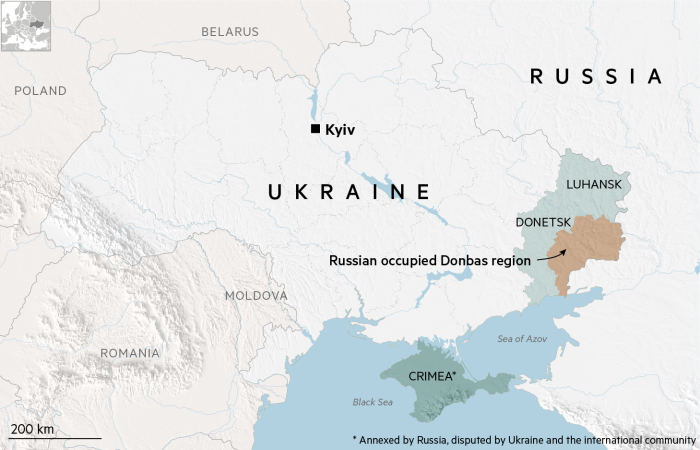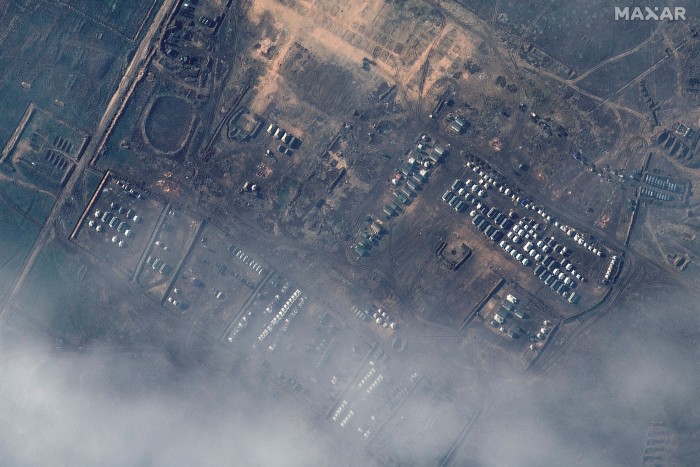As Vladimir Putin threatens possible military action on Ukraine, western military analysts say Russia’s president could contemplate a wide range of scenarios — from targeted missile strikes to a limited incursion from the east or south of the country, and even a full-scale invasion backed by cyber warfare.
After deploying about 100,000 Russian soldiers close to Ukraine’s northern, eastern and southern borders, Putin has warned he has “all kinds” of options if his demands over Ukraine and Nato’s activities in the former Soviet bloc are unmet.
US intelligence shared with European allies suggests Russia is preparing a possible invasion, according to US and EU officials, who gave the caveat that Putin had not yet made a final decision. The troop build-up could be aimed at securing diplomatic concessions from US President Joe Biden, they noted. The US and Russian leaders are due to speak on the phone on Thursday ahead of negotiations between Russia, the US and Nato member states in January.
However, the deployment of major units and sophisticated weaponry, coupled with strident rhetoric, has raised the prospect of turning the slow-burning proxy war in Ukraine’s eastern Donbas region into a full-blown conflict. More than 14,000 people have been killed since the fighting began shortly after Russia annexed Ukraine’s Crimean peninsula in 2014.
“Putin has the best track record of using force to achieve political ends of any leader by far,” said Michael Kofman, a senior research scientist at CNA, a US policy studies non-profit organisation. “How many offensives does he have to conduct in Ukraine for people to think he’s not bluffing?”
Putin has denied making plans for an invasion but has made it clear that Russia is prepared to use “appropriate military-technical measures” to “react harshly to hostile steps”.

A limited invasion
Two longtime confidants of Putin said the most likely casus belli would resemble the one that triggered the four-day war with Georgia in 2008. Russia at that time responded to Tbilisi’s attempts to secure territory held by Moscow-backed rebels with a land invasion supported by air and artillery strikes, a naval blockade and cyber attacks.
Russia would frame the conflict with Ukraine as a move to protect the Russian-speaking Donbas from what it would describe as Ukrainian aggression, they said. Donbas is home to two self-proclaimed separatist statelets where Moscow has given many residents Russian citizenship in recent years. Russia has led the separatist forces throughout the conflict and used its army to overwhelm Ukraine’s forces in 2014 and 2015, prompting Kyiv to make concessions at peace talks.
The scale and duration of any escalation would then depend on how quickly Ukraine capitulated to Russia’s demands, security experts say.
Western intelligence officials said that by mid-December, Russia had assembled about 100,000 troops in the vicinity of the Ukrainian border, including roughly 50 highly mobile and flexible Battalion Tactical Groups. They forecast about 175,000 troops would be deployed by the end of January, when the terrain would be frozen and therefore more suitable for tanks in case of a land invasion.

The current deployments lacked the full scope of logistical support necessary for a sustained operation — such as ammunition stocks, field hospitals and blood banks — but there was evidence Moscow was in the process of moving these towards the border, the western officials said.
“If they want to quickly plus this up for an invasion, they can do that on short notice with relatively little warning,” said Rob Lee, a fellow at the Foreign Policy Research Institute who researches Russia’s military. “Much of the personnel is likely still back in Siberia, but if they want to quickly get it moving, it’s much faster to fly out those guys instead of moving the equipment itself.”
Targeted air strikes
Russia could inflict significant damage on Ukraine’s military through aerial assaults on the front lines, military facilities and critical infrastructure, according to Dara Massicot, a senior policy researcher at the Rand Corporation.
Though Russia’s air force has not flown against a hostile air defence since the Georgian war, “there’s plenty of cruise and ballistic missiles that can come into play here from either the Black Sea or from the Russian homeland, and the Ukrainian air defence system will struggle to cope”, Massicot said.
A potential strike could use airborne missiles as well as heavy artillery and long-range flamethrowers, she added. “That would be incredibly devastating on Ukrainian land power,” she said.
Ukraine, a country of some 41m, has vowed to resist any Russian invasion. A poll this month by the Kyiv International Institute of Sociology suggests that 58 per cent of all men are ready to take up arms against Russia in case of a deeper invasion. Some have joined makeshift civilian defence forces.

But Russia’s military superiority would enable it to overrun Ukraine’s army in weeks by launching assaults on multiple fronts — including from Belarus and the Black Sea, according to Kofman.
“They’re defending the eastern flank of the largest country in Europe, and what do they have? They could very easily be cut off and isolated in the eastern part of Ukraine, which is why they may well find themselves fighting an organised retreat if faced with a multipronged attack,” Kofman said.
Full-scale invasion
A full-blown invasion would allow Russia to take over swaths of territory that could be used for a counter-offensive in the Donbas. It would also play to Putin’s notion that Ukraine’s Russian-speaking areas east of the Dnipro river are Moscow’s “historical territories”.
Analysts consider that scenario less likely because of the enormous manpower it would require and likely significant casualties for Russian forces.
But the extent of the assault would ultimately depend on how much damage Moscow had to inflict to force Ukraine to admit defeat, according to Lee.
“They could inflict tens of thousands of casualties after a couple of days. They could significantly degrade Ukraine’s military capability in the east. But would that be enough to force Ukraine to concede? That comes down to their cost-benefit analysis,” Lee said.
Additional reporting by Henry Foy in Brussels and Roman Olearchyk in Kyiv
Air strikes or invasion: what are Putin’s military options for Ukraine
Pinoy Variant